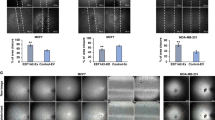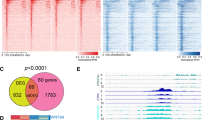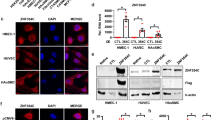Abstract
The mechanisms that are responsible for the restricted pattern of expression of the VE-cadherin gene in endothelial cells are not clearly understood. Regulation of expression is under the control of an approximately 140 bp proximal promoter that provides basal, non-endothelial specific expression. A larger region contained within the 2.5 kb genomic DNA sequence located ahead of the transcription start is involved in the specific expression of the gene in endothelial cells. We show here that the VE-cadherin promoter contains several putative hypoxia response elements (HRE) which are able to bind endothelial nuclear factors under normoxia. The VE-cadherin gene is not responsive to hypoxia but hypoxia-inducible factor (HIF)-2α specifically activates the promoter while HIF-1α does not. The HRE, that are involved in this activity have been identified. Further, we show that HIF-2α cooperates with the Ets-1 transcription factor for activation of the VE-cadherin promoter and that this synergy is dependent on the binding of Ets-1 to DNA. This cooperative action of HIF-2α with Ets-1 most probably participates to the transcriptional regulation of expression of the gene in endothelial cells. This mechanism may also be involved in the expression of the VE-cadherin gene by tumor cells in the process of vascular mimicry.
This is a preview of subscription content, access via your institution
Access options
Subscribe to this journal
Receive 50 print issues and online access
$259.00 per year
only $5.18 per issue
Buy this article
- Purchase on Springer Link
- Instant access to full article PDF
Prices may be subject to local taxes which are calculated during checkout








Similar content being viewed by others
References
Baek JH, Mahon PC, Oh J, Kelly B, Krishnamachary B, Pearson M et al. (2005). OS-9 interacts with hypoxia-inducible factor 1alpha and prolyl hydroxylases to promote oxygen-dependent degradation of HIF-1alpha. Mol Cell 17: 503–512.
Brahimi-Horn C, Mazure N, Pouyssegur J . (2005). Signalling via the hypoxia-inducible factor-1alpha requires multiple posttranslational modifications. Cell Signal 17: 1–9.
Breier G, Breviario F, Caveda L, Berthier R, Schnürch H, Gotsch U et al. (1996). Molecular cloning and expression of murine vascular endothelial-cadherin in early stage development of cardiovascular system. Blood 87: 630–641.
Bruick RK, McKnight SL . (2001). A conserved family of prolyl-4-hydroxylases that modify HIF. Science 294: 1337–1340.
Carmeliet P, Lampugnani MG, Moons L, Breviario F, Compernolle V, Bono F et al. (1999). Targeted deficiency or cytosolic truncation of the VE-cadherin gene in mice impairs VEGF-mediated endothelial survival and angiogenesis. Cell 98: 147–157.
Caveda L, Martin-Padura I, Navarro P, Breviario F, Corada M, Gulino D et al. (1996). Inhibition of cultured cell growth by vascular endothelial cadherin (Cadherin-5/VE-cadherin). J Clin Invest 98: 886–893.
Corada M, Mariotti M, Thurston G, Smith K, Kunkel R, Brockhaus M et al. (1999). Vascular endothelial-cadherin is an important determinant of microvascular integrity in vivo. Proc Natl Acad Sci USA 96: 9815–9820.
Coulet F, Nadaud S, Agrapart M, Soubrier F . (2003). Identification of hypoxia-response element in the human endothelial nitric-oxide synthase gene promoter. J Biol Chem 278: 46230–46240.
Covello KL, Kehler J, Yu H, Gordan JD, Arsham AM, Hu CJ et al. (2006). HIF-2alpha regulates Oct-4: effects of hypoxia on stem cell function, embryonic development, and tumor growth. Genes Dev 20: 557–570.
Covello KL, Simon MC, Keith B . (2005). Targeted replacement of hypoxia-inducible factor-1alpha by a hypoxia-inducible factor-2alpha knock-in allele promotes tumor growth. Cancer Res 65: 2277–2286.
Duan LJ, Zhang-Benoit Y, Fong GH . (2005). Endothelium-intrinsic requirement for Hif-2alpha during vascular development. Circulation 111: 2227–2232.
Elvert G, Kappel A, Heidenreich R, Englmeier U, Lanz S, Acker T et al. (2003). Cooperative interaction of hypoxia-inducible factor-2alpha (HIF-2alpha) and Ets-1 in the transcriptional activation of vascular endothelial growth factor receptor-2 (Flk-1). J Biol Chem 278: 7520–7530.
Ema M, Taya S, Yokotani N, Sogawa K, Matsuda Y, Fujii-Kuriyama Y . (1997). A novel bHLH-PAS factor with close sequence similarity to hypoxia-inducible factor 1 alpha regulates the VEGF expression and is potentially involved in lung and vascular development. Proc Natl Acad Sci USA 94: 4273–4278.
Flamme I, Frohlich T, von Reutern M, Kappel A, Damert A, Risau W . (1997). HRF, a putative basic helix-loop-helix-PAS-domain transcription factor is closely related to hypoxia-inducible factor-1 alpha and developmentally expressed in blood vessels. Mech Dev 63: 51–60.
Forsythe JA, Jiang BH, Iyer NV, Agani F, Leung SW, Koos RD et al. (1996). Activation of vascular endothelial growth factor gene transcription by hypoxia-inducible factor 1. Mol Cell Biol 16: 4604–4613.
Gavard J, Gutkind JS . (2006). VEGF controls endothelial-cell permeability by promoting the beta-arrestin-dependent endocytosis of VE-cadherin. Nat Cell Biol 8: 1223–1234.
Gory S, Dalmon J, Prandini M-H, Kortulewski T, de Launoit Y, Huber P . (1998). Requirement of a GT box (Sp1 site) and two Ets binding sites for vascular endothelial cadherin gene transcription. J Biol Chem 273: 6750–6755.
Gory S, Vernet M, Laurent M, Dejana E, Dalmon J, Huber P . (1999). The vascular endothelial-cadherin promoter directs endothelial-specific expression in transgenic mice. Blood 93: 184–192.
Gory-Fauré S, Prandini MH, Pointu H, Roullot V, Pignot-Paintrand I, Vernet M et al. (1999). Role of vascular endothelial-cadherin in vascular morphogenesis. Development 126: 2093–2102.
Gulino D, Delachanal E, Concord E, Genoux Y, Morand B, Valiron MO et al. (1998). Alteration of endothelial cell monolayer integrity triggers resynthesis of vascular endothelium cadherin. J Biol Chem 273: 29786–29793.
Hegen A, Koidl S, Weindel K, Marme D, Augustin HG, Fiedler U . (2004). Expression of angiopoietin-2 in endothelial cells is controlled by positive and negative regulatory promoter elements. Arterioscler Thromb Vasc Biol 24: 1803–1809.
Hisatsune H, Matsumura K, Ogawa M, Uemura A, Kondo N, Yamashita JK et al. (2005). High level of endothelial cell-specific gene expression by a combination of the 5′ flanking region and the 5′ half of the first intron of the VE-cadherin gene. Blood 105: 4657–4663.
Hu CJ, Wang LY, Chodosh LA, Keith B, Simon MC . (2003). Differential roles of hypoxia-inducible factor 1alpha (HIF-1alpha) and HIF-2alpha in hypoxic gene regulation. Mol Cell Biol 23: 9361–9374.
Iurlaro M, Demontis F, Corada M, Zanetta L, Drake C, Gariboldi M et al. (2004). VE-cadherin expression and clustering maintain low levels of survivin in endothelial cells. Am J Pathol 165: 181–189.
Ivan M, Kondo K, Yang H, Kim W, Valiando J, Ohh M et al. (2001). HIFalpha targeted for VHL-mediated destruction by proline hydroxylation: implications for O2 sensing. Science 292: 464–468.
Jaakkola P, Mole DR, Tian YM, Wilson MI, Gielbert J, Gaskell SJ et al. (2001). Targeting of HIF-alpha to the von Hippel-Lindau ubiquitylation complex by O2-regulated prolyl hydroxylation. Science 292: 468–472.
Jain S, Maltepe E, Lu MM, Simon C, Bradfield CA . (1998). Expression of ARNT, ARNT2, HIF1 alpha, HIF2 alpha and Ah receptor mRNAs in the developing mouse. Mech Dev 73: 117–123.
Jiang BH, Rue E, Wang GL, Roe R, Semenza GL . (1996). Dimerization, DNA binding, and transactivation properties of hypoxia-inducible factor 1. J Biol Chem 271: 17771–17778.
Kaelin Jr WG . (2002). How oxygen makes its presence felt. Genes Dev 16: 1441–1445.
Lampugnani MG, Resnati M, Raiteri M, Pigott R, Pisacane A, Houen G et al. (1992). A novel endothelial-specific membrane protein is a marker of cell-cell contacts. J Cell Biol 118: 1511–1522.
Lelièvre E, Lionneton F, Mattot V, Spruyt N, Soncin F . (2002). Ets-1 Regulates fli-1 Expression in Endothelial Cells. Identification of ETS-binding sites in the fli-1 gene promoter. J Biol Chem 277: 25143–25151.
Lelièvre E, Lionneton F, Soncin F, Vandenbunder B . (2001). The Ets family contains transcriptional activators and repressors involved in angiogenesis. Int J Biochem Cell Biol 33: 391–407.
Lelièvre E, Mattot V, Huber P, Vandenbunder B, Soncin F . (2000). Ets1 lowers capillary endothelial cell density at confluence and induces the expression of VE-cadherin. Oncogene 19: 2438–2446.
Lionneton F, Lelievre E, Baillat D, Stehelin D, Soncin F . (2003). Characterization and functional analysis of the p42Ets-1 variant of the mouse Ets-1 transcription factor. Oncogene 22: 9156–9164.
Lofstedt T, Fredlund E, Holmquist-Mengelbier L, Pietras A, Ovenberger M, Poellinger L et al. (2007). Hypoxia inducible factor-2alpha in cancer. Cell Cycle 6: 919–926.
May C, Doody JF, Abdullah R, Balderes P, Xu X, Chen CP et al. (2005). Identification of a transiently exposed VE-cadherin epitope that allows for specific targeting of an antibody to the tumor neovasculature. Blood 105: 4337–4344.
Maynard MA, Qi H, Chung J, Lee EH, Kondo Y, Hara S et al. (2003). Multiple splice variants of the human HIF-3 alpha locus are targets of the von Hippel-Lindau E3 ubiquitin ligase complex. J Biol Chem 278: 11032–11040.
Millauer B, Wizigmann-Voos S, Schnürch H, Martinez R, Moller NPH, Risau W et al. (1993). High affinity VEGF binding and developmental expression suggest Flk-1 as a major regulator of vasculogenesis and angiogenesis. Cell 72: 835–846.
Navarro P, Caveda L, Breviario F, Mandoteanu I, Lampugnani MG, Dejana E . (1995). Catenin-dependent and -independent functions of vascular endothelial cadherin. J Biol Chem 270: 30965–30972.
O'Rourke JF, Tian YM, Ratcliffe PJ, Pugh CW . (1999). Oxygen-regulated and transactivating domains in endothelial PAS protein 1: comparison with hypoxia-inducible factor-1alpha. J Biol Chem 274: 2060–2071.
Peng J, Zhang L, Drysdale L, Fong GH . (2000). The transcription factor EPAS-1/hypoxia-inducible factor 2alpha plays an important role in vascular remodeling. Proc Natl Acad Sci USA 97: 8386–8391.
Raval RR, Lau KW, Tran MG, Sowter HM, Mandriota SJ, Li JL et al. (2005). Contrasting properties of hypoxia-inducible factor 1 (HIF-1) and HIF-2 in von Hippel-Lindau-associated renal cell carcinoma. Mol Cell Biol 25: 5675–5686.
Rosenberger C, Mandriota S, Jurgensen JS, Wiesener MS, Horstrup JH, Frei U et al. (2002). Expression of hypoxia-inducible factor-1alpha and -2alpha in hypoxic and ischemic rat kidneys. J Am Soc Nephrol 13: 1721–1732.
Sambrook J, Fritsch E, Maniatis T . (1989). Molecular cloning: A laboratory manual, 2nd edn. Cold Spring Harbor Laboratory Press: Cold Spring Harbor.
Sato TN, Qin Y, Kozak CA, Audus KL . (1993). tie-1 and tie-2 define another class of putative receptor tyrosine kinase genes expressed in early embryonic vascular system. Proc Natl Acad Sci USA 90: 9355–9358.
Schnürch H, Risau W . (1993). Expression of tie-2, a member of a novel family of receptor tyrosine kinases, in the endothelial cell lineage. Development 119: 957–968.
Semenza GL . (2003). Targeting HIF-1 for cancer therapy. Nat Rev Cancer 3: 721–732.
Semenza GL, Jiang BH, Leung SW, Passantino R, Concordet JP, Maire P et al. (1996). Hypoxia response elements in the aldolase A, enolase 1, and lactate dehydrogenase A gene promoters contain essential binding sites for hypoxia-inducible factor 1. J Biol Chem 271: 32529–32537.
Semenza GL, Nejfelt MK, Chi SM, Antonarakis SE . (1991). Hypoxia-inducible nuclear factors bind to an enhancer element located 3' to the human erythropoietin gene. Proc Natl Acad Sci USA 88: 5680–5684.
Shweiki D, Itin A, Soffer D, Keshet E . (1992). Vascular endothelial growth factor induced by hypoxia may mediate hypoxia-initiated angiogenesis. Nature 359: 843–845.
Soncin F, Mattot V, Lionneton F, Spruyt N, Lepretre F, Begue A et al. (2003). VE-statin, an endothelial repressor of smooth muscle cell migration. Embo J 22: 5700–5711.
Sowter HM, Raval RR, Moore JW, Ratcliffe PJ, Harris AL . (2003). Predominant role of hypoxia-inducible transcription factor (Hif)-1alpha versus Hif-2alpha in regulation of the transcriptional response to hypoxia. Cancer Res 63: 6130–6134.
Talks KL, Turley H, Gatter KC, Maxwell PH, Pugh CW, Ratcliffe PJ et al. (2000). The expression and distribution of the hypoxia-inducible factors HIF-1alpha and HIF-2alpha in normal human tissues, cancers, and tumor-associated macrophages. Am J Pathol 157: 411–421.
Teruyama K, Abe M, Nakano T, Takahashi S, Yamada S, Sato Y . (2001). Neuropilin-1 is a downstream target of transcription factor Ets-1 in human umbilical vein endothelial cells. FEBS Lett 504: 1–4.
Tian H, Hammer RE, Matsumoto AM, Russell DW, McKnight SL . (1998). The hypoxia-responsive transcription factor EPAS1 is essential for catecholamine homeostasis and protection against heart failure during embryonic development. Genes Dev 12: 3320–3324.
Tian H, McKnight SL, Russell DW . (1997). Endothelial PAS domain protein 1 (EPAS1), a transcription factor selectively expressed in endothelial cells. Genes Dev 11: 72–82.
Wang GL, Jiang BH, Rue EA, Semenza GL . (1995). Hypoxia-inducible factor 1 is a basic-helix-loop-helix-PAS heterodimer regulated by cellular O2 tension. Proc Natl Acad Sci USA 92: 5510–5514.
Wang GL, Semenza GL . (1993). General involvement of hypoxia-inducible factor 1 in transcriptional response to hypoxia. Proc Natl Acad Sci USA 90: 4304–4308.
Wang GL, Semenza GL . (1995). Purification and characterization of hypoxia-inducible factor 1. J Biol Chem 270: 1230–1237.
Wang V, Davis DA, Haque M, Huang LE, Yarchoan R . (2005). Differential gene up-regulation by hypoxia-inducible factor-1alpha and hypoxia-inducible factor-2alpha in HEK293 T cells. Cancer Res 65: 3299–3306.
Wiesener MS, Jurgensen JS, Rosenberger C, Scholze CK, Horstrup JH, Warnecke C et al. (2003). Widespread hypoxia-inducible expression of HIF-2alpha in distinct cell populations of different organs. FASEB J 17: 271–273.
Wiesener MS, Turley H, Allen WE, Willam C, Eckardt KU, Talks KL et al. (1998). Induction of endothelial PAS domain protein-1 by hypoxia: characterization and comparison with hypoxia-inducible factor-1alpha. Blood 92: 2260–2268.
Acknowledgements
We thank Dr P Huber for providing us the H5 V and 3T3 cells, Drs M Gassman and D Russell for providing us with the HIF-1 and EPAS-1 expression plasmids. This work was funded by Ligue Nationale contre le Cancer (Equipe labellisée La Ligue 2005), Association for International Cancer Research, Association pour la Recherche sur le Cancer, and Fondation de France. AL, EL, BC and FL were recipients of Ligue Nationale contre le Cancer fellowships. FS is Directeur de Recherche INSERM.
Author information
Authors and Affiliations
Corresponding author
Rights and permissions
About this article
Cite this article
Le Bras, A., Lionneton, F., Mattot, V. et al. HIF-2α specifically activates the VE-cadherin promoter independently of hypoxia and in synergy with Ets-1 through two essential ETS-binding sites. Oncogene 26, 7480–7489 (2007). https://doi.org/10.1038/sj.onc.1210566
Received:
Revised:
Accepted:
Published:
Issue Date:
DOI: https://doi.org/10.1038/sj.onc.1210566
Keywords
This article is cited by
-
Mechanisms of vasculogenic mimicry in hypoxic tumor microenvironments
Molecular Cancer (2021)
-
Biomaterial-induced conversion of quiescent cardiomyocytes into pacemaker cells in rats
Nature Biomedical Engineering (2021)
-
Acute and chronic hypoxia differentially predispose lungs for metastases
Scientific Reports (2019)
-
SOD3 improves the tumor response to chemotherapy by stabilizing endothelial HIF-2α
Nature Communications (2018)
-
Intestinal hypoxia and hypoxia-induced signalling as therapeutic targets for IBD
Nature Reviews Gastroenterology & Hepatology (2017)



